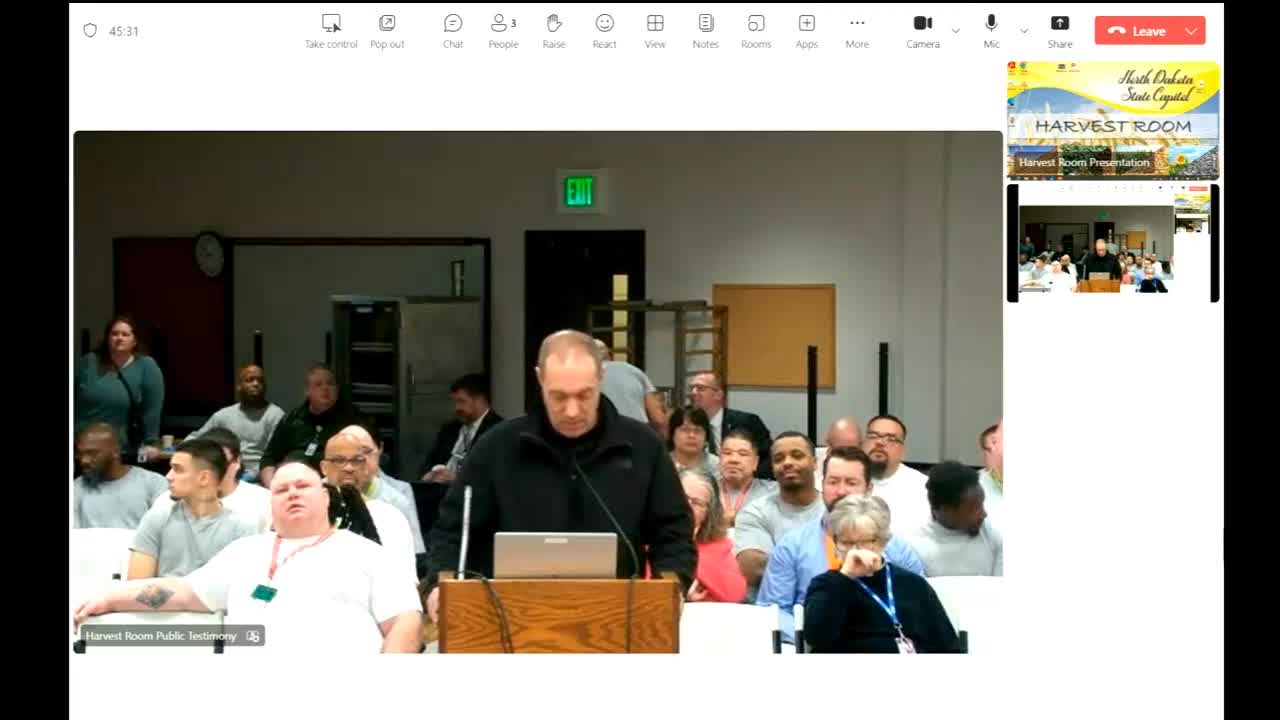NDSP staff and residents say orientation, dynamic security and resident programs change facility culture
February 04, 2025 | Appropriations - Human Resources Division, Senate, Legislative, North Dakota
This article was created by AI summarizing key points discussed. AI makes mistakes, so for full details and context, please refer to the video of the full meeting. Please report any errors so we can fix them. Report an error »

Staff and residents at the North Dakota State Penitentiary told the Senate Appropriations Human Resources Division that a centralized orientation unit, emphasis on normality and resident leadership are central to changing prison culture.
"Our orientation unit consists of 148 beds that are almost always full," said Joshua Hewson, the orientation case manager. Hewson said orientation is the first stop for male residents and that staff spend five weeks interviewing and assessing people to avoid snap judgements based only on the current charge.
Unit manager Lacey Zander described "dynamic security," a staff approach that prioritizes relationships, rapport and routines that replicate normal community responsibilities. "With the normality principle ' ' 97 percent of people will be getting out, they will be our neighbors," she said. "We don't need to continue to punish people simply because they are here." Preferred housing examples given included keys to rooms, cooking and laundry access.
Residents credited resident workers and peer programs for helping reduce incidents and for building prosocial norms. Christian Tolbert, a resident worker in orientation, said a welcoming sign that reads "Welcome. Change starts here" helps calm new arrivals and that resident‑run Bible study regularly draws large attendance. Antonio Stradern, a resident, said normal daily skills such as washing clothes and cooking were "normal" for NDSP but rare elsewhere and that those experiences help people plan for reentry.
Why it matters: Presenters and resident witnesses said centralized orientation, consistent messaging and resident participation create measurable benefits: fewer incident reports in orientation, more positive behavior reports and a culture where residents report peer accountability and mutual support.
Committee exchange: Senators asked whether orientation is centralized for all incoming men and whether the cultural change was visible across the institution; Hewson said all men come through NDSP orientation and staff track unofficial statistics showing fewer repeat negative behaviors among new arrivals.
Ending: Legislators heard requests for continued funding for programs and for continued emphasis on the normality and resident‑led approaches; no formal votes were recorded during the visit.
"Our orientation unit consists of 148 beds that are almost always full," said Joshua Hewson, the orientation case manager. Hewson said orientation is the first stop for male residents and that staff spend five weeks interviewing and assessing people to avoid snap judgements based only on the current charge.
Unit manager Lacey Zander described "dynamic security," a staff approach that prioritizes relationships, rapport and routines that replicate normal community responsibilities. "With the normality principle ' ' 97 percent of people will be getting out, they will be our neighbors," she said. "We don't need to continue to punish people simply because they are here." Preferred housing examples given included keys to rooms, cooking and laundry access.
Residents credited resident workers and peer programs for helping reduce incidents and for building prosocial norms. Christian Tolbert, a resident worker in orientation, said a welcoming sign that reads "Welcome. Change starts here" helps calm new arrivals and that resident‑run Bible study regularly draws large attendance. Antonio Stradern, a resident, said normal daily skills such as washing clothes and cooking were "normal" for NDSP but rare elsewhere and that those experiences help people plan for reentry.
Why it matters: Presenters and resident witnesses said centralized orientation, consistent messaging and resident participation create measurable benefits: fewer incident reports in orientation, more positive behavior reports and a culture where residents report peer accountability and mutual support.
Committee exchange: Senators asked whether orientation is centralized for all incoming men and whether the cultural change was visible across the institution; Hewson said all men come through NDSP orientation and staff track unofficial statistics showing fewer repeat negative behaviors among new arrivals.
Ending: Legislators heard requests for continued funding for programs and for continued emphasis on the normality and resident‑led approaches; no formal votes were recorded during the visit.
View full meeting
This article is based on a recent meeting—watch the full video and explore the complete transcript for deeper insights into the discussion.
View full meeting
